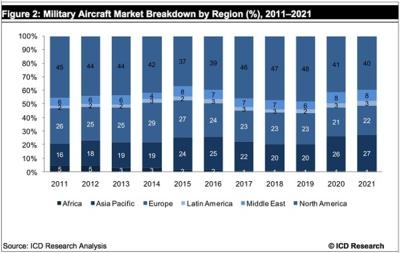North America Should Account for Nearly 43% Of Global
Expenditures Over The Next Ten Years
North America is expected to account for 42.9%, of the
total global expenditure on military aircraft over the next ten
years despite expected cuts in its military budget, according to a
recently-released report from ASDReports. The high demand in the
region is primarily driven by the development of 2,456 F-35
multi-role fighter aircraft as part of the Joint Strike Fighter
program and 452 V-22 Osprey transport aircraft. Europe and Asia are
also expected to account for a significant portion of the total
military aircraft during the forecast period, with shares of 24.1%
and 21.8% respectively.

Many countries are expected to replace their ageing military
aircraft fleet during the forecast period. The wars in Afghanistan
and Iraq has meant that the US, which is the biggest market for
military aircraft and other allied countries in Europe,
Asia-Pacific, Latin America and the Middle East, need to replace
their aircraft which have been in continuous use over the last
decade.
The global environment is characterized by ongoing tensions and
conflicts among various countries around the world which is
supporting demand for military aircraft. Historically, countries
follow a policy of enhancing their military as a deterrent to
hostile nations and consequently the military aircraft market is
recording strong growth despite the commercial aircraft industry
exhibiting a downward trend.
The market for advanced trainer aircraft across the globe is
growing, which is attributed to the significant number of countries
involved in the process of upgrading to next-generation combat
aircraft fleets. In meeting this growing demand, manufacturers are
developing trainer aircraft that are able to perform a number of
training roles for the armed forces of the countries involved in
the procurement process.
Many nations around the world are involved in border disputes
which have resulted in strained military relations. Some of these
disputes could be resolved amicably through talks while others have
the potential to escalate into a military conflict. Therefore
countries across the world are expected to invest in reconnaissance
and surveillance aircraft to safeguard borders.
In terms of categories, the multi-role aircraft is expected to
account for the highest proportion of spending in the global
military aircraft market. Following the budget cuts announced by
various countries as a result of the global economic recession, the
procurement of multi-role aircraft has increased significantly due
to their ability to carry out various missions including attack,
reconnaissance, rescue operations and transport.

To increase the capabilities of modern military aircraft, the
global defense industry is investing significantly in R&D which
has led to the development of technologies to enhance the speed,
power, stealth capabilities, destructive force and takeoff and
landing capabilities of the various types of military aircraft.
The global economic slowdown has reduced military expenditure
worldwide, as a consequence of which a significant number of
countries are establishing joint projects in order to share R&D
costs. Partnerships between defense firms have also increased as a
significant number of countries are investing in the development of
their domestic military aircraft development capabilities, by
establishing strategic alliances and technology-transfer agreements
with global military aircraft manufacturers.
The global economic slowdown has reduced the defense budgets of
most leading spenders in the world, including the US, France,
Germany and the UK. Cuts to military expenditure have led to the
cancellation and indefinite delays of various military aircraft
programs, and are having a detrimental impact on the growth of the
industry.
 Airbus Racer Helicopter Demonstrator First Flight Part of Clean Sky 2 Initiative
Airbus Racer Helicopter Demonstrator First Flight Part of Clean Sky 2 Initiative Diamond's Electric DA40 Finds Fans at Dübendorf
Diamond's Electric DA40 Finds Fans at Dübendorf ANN's Daily Aero-Term (04.23.24): Line Up And Wait (LUAW)
ANN's Daily Aero-Term (04.23.24): Line Up And Wait (LUAW) NTSB Final Report: Extra Flugzeugbau GMBH EA300/L
NTSB Final Report: Extra Flugzeugbau GMBH EA300/L Classic Aero-TV: 'Never Give Up' - Advice From Two of FedEx's Female Captains
Classic Aero-TV: 'Never Give Up' - Advice From Two of FedEx's Female Captains




